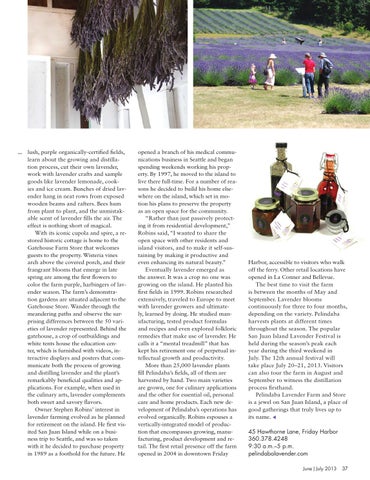…
lush, purple organically-certified fields, learn about the growing and distillation process, cut their own lavender, work with lavender crafts and sample goods like lavender lemonade, cookies and ice cream. Bunches of dried lavender hang in neat rows from exposed wooden beams and rafters. Bees hum from plant to plant, and the unmistakable scent of lavender fills the air. The effect is nothing short of magical. With its iconic cupola and spire, a restored historic cottage is home to the Gatehouse Farm Store that welcomes guests to the property. Wisteria vines arch above the covered porch, and their frangrant blooms that emerge in late spring are among the first flowers to color the farm purple, harbingers of lavender season. The farm’s demonstration gardens are situated adjacent to the Gatehouse Store. Wander through the meandering paths and observe the surprising differences between the 50 varieties of lavender represented. Behind the gatehouse, a crop of outbuildings and white tents house the education center, which is furnished with videos, interactive displays and posters that communicate both the process of growing and distilling lavender and the plant’s remarkably beneficial qualities and applications. For example, when used in the culinary arts, lavender complements both sweet and savory flavors. Owner Stephen Robins’ interest in lavender farming evolved as he planned for retirement on the island. He first visited San Juan Island while on a business trip to Seattle, and was so taken with it he decided to purchase property in 1989 as a foothold for the future. He
opened a branch of his medical communications business in Seattle and began spending weekends working his property. By 1997, he moved to the island to live there full-time. For a number of reasons he decided to build his home elsewhere on the island, which set in motion his plans to preserve the property as an open space for the community. “Rather than just passively protecting it from residential development,” Robins said, “I wanted to share the open space with other residents and island visitors, and to make it self-sustaining by making it productive and even enhancing its natural beauty.” Eventually lavender emerged as the answer. It was a crop no one was growing on the island. He planted his first fields in 1999. Robins researched extensively, traveled to Europe to meet with lavender growers and ultimately, learned by doing. He studied manufacturing, tested product formulas and recipes and even explored folkloric remedies that make use of lavender. He calls it a “mental treadmill” that has kept his retirement one of perpetual intellectual growth and productivity. More than 25,000 lavender plants fill Pelindaba’s fields, all of them are harvested by hand. Two main varieties are grown, one for culinary applications and the other for essential oil, personal care and home products. Each new development of Pelindaba’s operations has evolved organically. Robins espouses a vertically-integrated model of production that encompasses growing, manufacturing, product development and retail. The first retail presence off the farm opened in 2004 in downtown Friday
Harbor, accessible to visitors who walk off the ferry. Other retail locations have opened in La Conner and Bellevue. The best time to visit the farm is between the months of May and September. Lavender blooms continuously for three to four months, depending on the variety. Pelindaba harvests plants at different times throughout the season. The p opular San Juan Island Lavender Festival is held during the s eason’s peak each year during the third weekend in July. The 12th a nnual f estival will take place July 20–21, 2013. Visitors can also tour the farm in August and September to witness the distillation process firsthand. Pelindaba Lavender Farm and Store is a jewel on San Juan Island, a place of good gatherings that truly lives up to its name. 45 Hawthorne Lane, Friday Harbor 360.378.4248 9:30 a.m.–5 p.m. pelindabalavender.com June | July 2013 37
